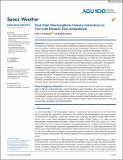| dc.contributor.author | Gondelach, David J | |
| dc.contributor.author | Linares, Richard | |
| dc.date.accessioned | 2021-10-27T20:23:29Z | |
| dc.date.available | 2021-10-27T20:23:29Z | |
| dc.date.issued | 2020 | |
| dc.identifier.uri | https://hdl.handle.net/1721.1/135442 | |
| dc.description.abstract | Inaccurate estimates of the thermospheric density are a major source of error in low Earth orbit prediction. In this work, we develop a reduced-order dynamic model for the thermospheric density by computing the main spatial modes of the atmosphere and deriving a linear model for the dynamics. This model is then used to estimate the density using two-line element (TLE) data by simultaneously estimating the reduced-order modes and the orbits and ballistic coefficients of several objects using an unscented Kalman filter. Accurate density estimation using the TLEs of 15 objects is demonstrated and validated against CHAMP and GRACE accelerometer-derived densities. Finally, the use of the model for density forecasting is shown. | |
| dc.language.iso | en | |
| dc.publisher | American Geophysical Union (AGU) | |
| dc.relation.isversionof | 10.1029/2019SW002356 | |
| dc.rights | Creative Commons Attribution 4.0 International license | |
| dc.rights.uri | https://creativecommons.org/licenses/by/4.0/ | |
| dc.source | American Geophysical Union (AGU) | |
| dc.title | Real‐Time Thermospheric Density Estimation via Two‐Line Element Data Assimilation | |
| dc.type | Article | |
| dc.contributor.department | Massachusetts Institute of Technology. Department of Aeronautics and Astronautics | |
| dc.relation.journal | Space Weather | |
| dc.eprint.version | Final published version | |
| dc.type.uri | http://purl.org/eprint/type/JournalArticle | |
| eprint.status | http://purl.org/eprint/status/PeerReviewed | |
| dc.date.updated | 2021-05-05T18:40:30Z | |
| dspace.orderedauthors | Gondelach, DJ; Linares, R | |
| dspace.date.submission | 2021-05-05T18:40:32Z | |
| mit.journal.volume | 18 | |
| mit.journal.issue | 2 | |
| mit.license | PUBLISHER_CC | |
| mit.metadata.status | Authority Work and Publication Information Needed | |
